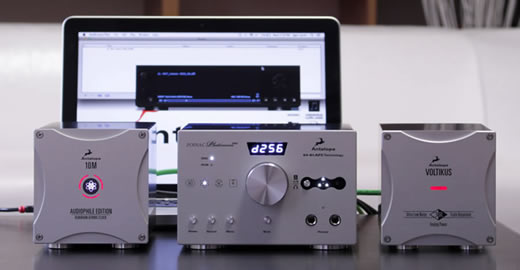- AccurateRip
- Acoustid
- AES/EBU
- AirPlay
- Amplifier
- aptX
- Audio file formats
- ASRC
- AVB
- Bit perfect jitter
- Bits: 16 or 24
- Bit perfect playback
- Bitrate
- Bluetooth
- Burn-in
- BWF
- Cables
- CDtext
- Chromecast
- Clipping
- Clock
- Codec
- Compression
- CRC
- Crossover
- Cue sheet
- DAC
- Damping
- DASH
- Digital
- Digital Room Correction
- Dither
- DLNA
- Drivers
- DoP
- DSP
- EBU R128 (loudness)
- FFT
- FireWire
- Freedb
- Gapless playback
- Generation loss
- HDMI
- Headphone listening
- Hearing
- Hires recording
- Homeplug
- I2S
- ID3
- Inter sample peak
- LDAC
- Linearity (DAC)
- Memory playback
- Music Server
- OCF
- OFC
- PCM
- Perception
- RAID
- ReplayGain
- Ripping
- RFI
- RIAA
- Router
- Sampling, up and over
- Sample Rate Conversion
- Speakers
- S/PDIF
- Storage
- Sync
- Tagging
- Toslink
- Transcoding
- UAA
- Units
- UPnP
- USB
- VST
- WiFi
- WiSA
Clock
The sample rate is generated by a clock.
Basically one applies a voltage to a crystal causing it to oscillate.
Obvious, nothing digital about the sample rate.
It is as analog as analog can be.
Analog means imperfection as 100% accuracy doesn't exist in our 100% analog world.
This imperfection has become known as jitter.
Slight variations in the duration of a cycle.
In the past, jitter was measured in nano seconds.
As the clocking improved, jitter was measured in pico seconds.
Calyx audio was the first to introduce a DAC with a femto clock (2012)
Its intrinsic jitter dropped below the 1 ps.
To give you an idea of the magnitude:
1 p = 0.000 000 000 001, a trillionth of a second.
1 f = 0.000 000 000 000 001, a quadrillionth of a second.
In about 25 years, jitter performance improved by a factor of 100.000.
Small wonder it is no longer an issue.
Pricing
Femto clocks are needed in computers and networks.
If a processor is screaming at 3 MHz, precision of the clocking is crucial for a correct functioning.
As the femto clock is a computer part, it is mass produced hence cheap.
To give you a idea:
Wyred For Sound offered an upgrade of its existing models to a 82 fSec phase jitter clock for $150,- (labor included).
Pitch
You can change the pitch by changing the clock speed
Redbook ( CD audio standard) requires the clocks frequency be within +/-100ppm (parts per million).
A deviation of 100 ppm means that a 440Hz tone deviates +/- 0.044Hz.
This is way below the treshold of our hearing even if you have absolute pitch.
External master clock
If you need to synchronize a couple of devices, you can use a master clock.
For playback only, a clock as close to the chip doing the DA is probably a better solution.
Present femto-clocks do beat the common rubidium atomic clock as used by most master clocks in the jitter department.
Observe that we are not so much interested in time keeping but in the stability of the cycle to cycle step.
Sound on Sound reviewed a couple of high quality master clocks.
Overall, it should be clear from these tests that employing an external master clock cannot and will not improve the sound quality of a digital audio system. It might change it, and subjectively that change might be preferred, but it won’t change things for the better in any technical sense. A-D conversion performance will not improve: the best that can be hoped for is that the A-D conversion won’t become significantly degraded. In most cases, the technical performance will actually become worse, albeit only marginally so.
Does Your Studio Need A Digital Master Clock? : SOS June 2010
It looks like an external clock will degrade the sound most of the time.

A €5,392 DAC
Clocked by a €7,338 Rubidium clock
Fed by a €1,675 PSU
Am I the only one who do thinks that if adding an external clock and an external PSU helps, this DAC must be equipped with both a lousy clock and a lousy PSU and still cost €5,392?
Master, bit and word clock
Word clock: the sample rate of the audio e.g. 44.1 kHz
Bit clock: the bit rate.
Assuming 16 bits words, 2 channel, 44.1 kHz the you have =16*2*44100= 1411200 bits per second.
The bit clock runs at double speed = 2822400 = 2.8224 MHz
The master clock runs a arbitrary number e.g. 4 times faster = 11.2896 MHz
Rock around the clock - What's Best Forum
Femto Clock in a Streamer - why ?? - Computer Audio Asylum
Auralic LEO GX DAC Clock Review - Audio Science Review


